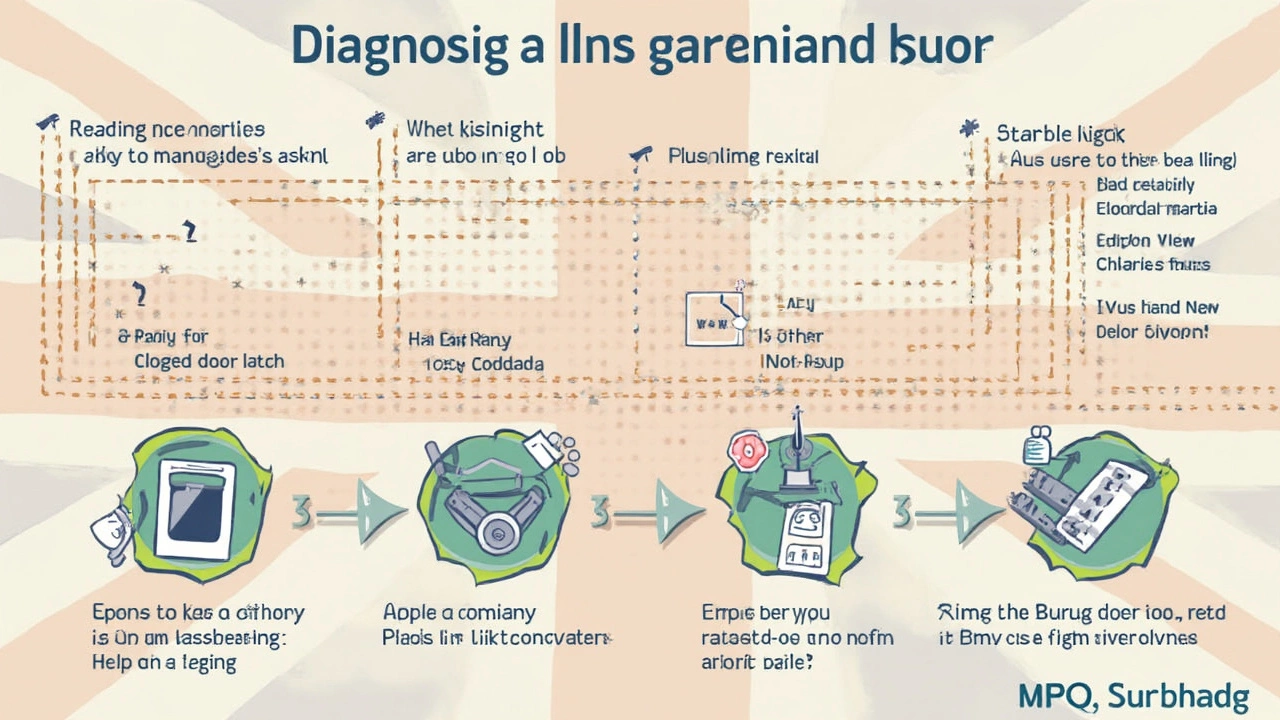Ever opened your dishwasher and found dirty plates staring back at you, even after a full cycle? You’re not alone. Dishwashers break down for all kinds of reasons, but the truth is—some fixes are easier than you might think. Most of the time, the problem is something basic like a clogged filter, a blocked spray arm, or a stuck float switch. These issues don’t need any special skills, just a little patience and some basic tools.
What trips people up is the fear of poking around inside an appliance with water and electricity involved. But modern dishwashers are built in layers, and the parts that cause the most trouble are right behind the door or under the bottom rack. You don’t need to be a tech expert or even particularly handy to swap out a filter or clean out some gunk. Just watch out for sharp edges and always unplug the thing first—nobody likes a surprise zap.
- Why Dishwashers Act Up: Common Problems
- Understanding What’s Under the Hood
- DIY Fixes You Can Actually Do
- Tools and Tricks for Easier Repairs
- When to Call a Pro Instead
- Keeping Your Dishwasher Trouble-Free
Why Dishwashers Act Up: Common Problems
Dishwashers usually wear out slowly, so the most common issues pop up long before the thing completely dies. Most of the time, you’ll notice things like standing water after a cycle, cloudy glassware, or a burning smell when it runs. The bulk of calls for dishwasher repair come down to a list of usual suspects—clogs, loose parts, or things not getting enough power or water.
Here are the issues people run into the most:
- Clogged filters: Food particles and grease can block the filter, causing dirty water to hang out at the bottom. Clean filters clear up more problems than you’d think.
- Spray arm problems: The arms that shoot water can get plugged up or stuck. If water isn’t spraying, the dishes won’t get clean—or you’ll hear strange noises during the cycle.
- Drain pump blockages: Gloves and toothpicks can end up inside the pump. If it’s jammed, you might see water pooling or get an error code flashing on the door.
- Door latch and seal wear: If the door won’t click shut, or water leaks by the door, the latch or rubber seals probably need attention.
- Float switch stuck: The float tells the machine how much water is inside. If debris gets under it, your dishwasher may not fill properly—or might never start at all.
- Heating element fails: If dishes aren’t drying or the cycle seems cold, the heater might be dead. Replacing this takes a little know-how and some tools, but a visible break in the wire is a dead giveaway.
Wondering which issues are actually the most common? Here’s a quick breakdown using manufacturer service call data from 2024:
| Problem | % of Service Calls |
|---|---|
| Clogged Filter or Spray Arm | 34% |
| Drain Pump Blockage | 26% |
| Door Latch/Seal Issues | 19% |
| Float Switch Problem | 11% |
| Heating Element Failure | 10% |
If your dishwasher is less than five years old, it's usually a small part or some leftover food debris causing chaos—not something major like a busted board. Knowing which parts commonly fail can save you a call to the repairman and a dent in your wallet.
Understanding What’s Under the Hood
If you’re going to tackle a dishwasher repair yourself, you’ve got to know what’s going on inside the machine. Dishwashers aren’t nearly as mysterious as they look from the outside. Most of the magic happens with just a handful of basic parts working together.
Here’s what you’ll find behind that door:
- Spray Arms: These spin around during the wash cycle, firing jets of water to blast away grime.
- Filter: Sits at the bottom and catches food bits so they don’t clog up your drain or mess with the pump.
- Door Latch: Makes sure the door stays closed tight—if it’s acting up, the dishwasher won’t even start.
- Float Switch: Prevents your kitchen from turning into a lake by shutting off the water if the level gets too high.
- Drain Pump: Kicks in at the end to send dirty water out of the machine.
- Heating Element: Warms up the water for a better clean and sometimes dries the dishes, too.
Most problems happen in the lower half—mainly the filter, spray arms, or drain area. That’s good news for DIY folks, because you can get to these parts without tearing the whole thing apart.
If you’re curious about the usual layout and parts, check this out:
| Part | Location | Common Issue |
|---|---|---|
| Filter | Bottom, under lower rack | Clogged with food |
| Spray Arm | Below and above racks | Blocked holes |
| Float Switch | Front corner of tub | Stuck or jammed |
| Drain Pump | Below filter area | Blockage or failure |
| Heating Element | Bottom, inside tub | Burned out |
| Door Latch | Top of door | Misaligned or broken |
Knowing where to look makes troubleshooting a lot less stressful. Most brands (Bosch, Whirlpool, Samsung, etc.) use nearly the same layout, so once you’ve seen the inside of one dishwasher, you’ll have a good idea of what’s happening with others too. The only time things get hairy is if you’re dealing with really old models or fancy features like smart touchscreens or hidden controls—those can be pricey and tricky to mess with, even for repair techs.
DIY Fixes You Can Actually Do
You don’t need to be an appliance genius to handle the basic stuff. Most common dishwasher repair jobs are way less intimidating than they sound. Seriously, you can tackle quite a few fixes with just a screwdriver, maybe a pair of pliers, and a willingness to get your hands a little dirty. Here’s what’s totally doable for the average person.
- Cleaning the Filter: A clogged filter is probably the number one reason for poor cleaning. Just pop out the bottom rack, twist the filter and rinse it under water. If it’s packed with gunk, soak it in warm soapy water for a few minutes. Do this once a month and you’ll prevent a ton of issues.
- Unclogging Spray Arms: Food chunks or hard water deposits block spray holes all the time. Take out the spray arms, poke out any bits with a toothpick, and rinse them. Easy.
- Fixing a Stuck Float: If your dishwasher isn’t filling with water, there’s a good chance the float is stuck. Wiggle it gently to make sure it moves up and down. A float that’s jammed stops the machine from running right.
- Resetting the Dishwasher: Some glitches just need a reset. Disconnect the power for a minute or two, then plug it back in. It’s basically a reboot for your dishwasher’s brain.
- Dealing with Leaks: Door gasket looking old and cracked? Swap it out. Replacements are cheap, and it’s usually as simple as peeling out the old one and pressing the new one into the channel.
Wondering what kind of problems you’re likely to face? Here’s a quick look at trouble spots, and how often they come up:
| Common Issue | DIY-Friendly? | Estimated Fix Time |
|---|---|---|
| Clogged filter | Yes | 10 minutes |
| Spray arm blockage | Yes | 15 minutes |
| Stuck float switch | Yes | 5 minutes |
| Worn door gasket | Yes | 15-20 minutes |
| Broken drain pump | No (call a pro) | — |
One thing worth mentioning: dishwashers made in the last ten years are simpler to work on than you might think. Most fixes that show up in online forums or how-to videos don’t even require you to move the appliance. Keep a towel handy for spills, snap a few photos as you go, and don’t be afraid to check your model’s user manual for diagrams. They’re more helpful than most people expect.

Tools and Tricks for Easier Repairs
If you want to tackle dishwasher repair without headaches, you’ll want the right tools and some smart workarounds. You actually don’t need a full garage of gear. Most fixes use things you might already have at home. Here’s the basic toolkit that’ll cover nearly every DIY job:
- Phillips and flathead screwdrivers – Most panels and parts are held with regular screws.
- Needle-nose pliers – Perfect for grabbing broken clips or fishing out gunk from hard-to-reach spots.
- Nut driver or small socket set – Some dishwashers use bolts, not screws, especially under the kick plate.
- Towel and a bucket – For catching water or spills when you disconnect hoses or open something up.
- Flashlight or headlamp – It’s dark under kitchen cabinets; seeing what you’re doing is half the battle.
- Multimeter – If your dishwasher won’t start, you can check if the fuse or door switch is dead.
One good tip: Snapping pictures with your phone while you work makes it easier to get everything back together later. Take notes on where clips or screws go—there’s always “that one extra” at the end.
People tend to forget to check for simple stuff. Resetting the dishwasher by flipping the breaker or unplugging it for 60 seconds can fix weird electronic glitches. If water isn’t draining, poke around for bits of bones, glass, or even pieces of the dishwasher itself clogged up in the filter. Don’t skip the owner’s manual either—most have a basic troubleshooting chart that actually helps.
Trouble remembering what things are supposed to look like? Search the model number online—there’s usually a diagram or even a YouTube guide someone made for your exact machine.
| Tool | Common Use |
|---|---|
| Phillips/Flathead Screwdriver | Opening panels, removing screens |
| Needle-nose Pliers | Removing debris, small parts |
| Nut Driver/Socket Set | Unbolting components |
| Multimeter | Checking electrical issues |
| Towel/Bucket | Managing leaks/spills |
| Flashlight | Inspecting hidden areas |
One last hack: Lay down an old yoga mat or a folded-up towel in front of the dishwasher so your knees don’t hate you after an hour on hard tile.
When to Call a Pro Instead
Some dishwasher issues really are too risky, complicated, or flat-out annoying to tackle on your own. Prying open control panels, messing with wiring, or figuring out why your dishwasher is flooding your kitchen can go sideways fast. If you hit one of these situations, it’s way safer—and often cheaper in the long run—to get a professional.
- Electrical Problems: Smell burning plastic? Is your dishwasher tripping the breaker every cycle? Walk away from that screwdriver. Electrical repairs can shock you and lead to even bigger repairs if done wrong.
- Water Leaks Underneath: If water pools under the unit or leaks out from the door seals despite cleaning, there might be a busted pump or cracked hoses hidden deep inside. These fixes often involve moving the whole appliance and working close to wiring.
- Control Panel or Computer Board Issues: When the buttons don’t respond, or your machine won’t start even after resetting it, the brain might be fried. Replacing a control board means dealing with delicate electronics and isn’t a casual DIY job.
- Strange Noises From the Motor: Grinding, screeching, or heavy rattling sounds from below usually point to a dying motor or busted bearings. Getting to these parts means disassembling half the dishwasher and risking serious damage if you slip up.
According to a 2024 survey published by HomeServe, nearly 62% of dishwasher service calls ended up needing special parts or advanced repairs regular folks can’t do with just a basic toolkit. Plus, most manufacturers void the warranty if someone unlicensed messes with electronics or complex plumbing!
| Repair Type | DIY or Pro Needed? | Average Pro Cost (USD) |
|---|---|---|
| Replace Door Gasket | Usually DIY | $80–$150 |
| Replace Heating Element | Pro Recommended | $150–$350 |
| Main Control Board Swap | Pro Only | $250–$600 |
| Motor Repair/Replace | Pro Only | $300–$500 |
Bottom line: if you’re dealing with anything electrical, a water leak you can’t see, or electronics that look like a spaceship’s dashboard, call a pro. You’ll save time, money, and maybe a trip to the ER. If you want to keep that dishwasher repair from turning into a kitchen disaster, know your limits.
Keeping Your Dishwasher Trouble-Free
No one likes dealing with surprise repairs, so regular maintenance is the real secret to sidestepping most dishwasher repair headaches. Luckily, it doesn’t take much time or effort to keep things running smooth—just some simple habits can make your dishwasher last way longer and work better.
- Clean the filter every month. The filter catches food scraps and gunk before they clog up the works. Pop it out, rinse it under the tap, and scrub it with a soft brush. Skip this step, and you’ll notice dirty dishes and standing water in no time.
- Wipe down the spray arms. These little guys get clogged with mineral deposits or food bits, making your dishwasher spray like an old garden hose. Use a toothpick or small brush to clear the holes every few months.
- Run a cleaning cycle. Once a month, run a cycle with nothing but a cup of white vinegar on the top rack. It cuts down on smells, grease, and hard water buildup. If you see a white, chalky film inside, toss in a handful of baking soda and run another quick wash.
- Check and clean the door seal. Food and mold can build up around the rubber gasket, causing leaks and funky smells. Wipe it with warm, soapy water—don’t forget the folds where gunk hides.
- Don’t overload it. Overstuffing the racks blocks the spray and keeps dishes dirty. Give plates and bowls a little space, so water can actually hit them.
- Use the right detergent. Stick with dishwasher-specific soap—regular dish soap makes a bubbly disaster. If you deal with hard water, grab detergents made for it to cut down on spots.
Another thing: hot water helps dishwashers work best. If you haven’t already, run your kitchen tap until it’s hot before starting the dishwasher. And if something doesn’t sound or look right, like weird noises or leftover water, tackle the problem early before it grows into a mess.
Stick with these tips, and your dishwasher will save you time, money, and hassle for years. It’s really just a couple minutes every so often, but the payoff is worth it.




